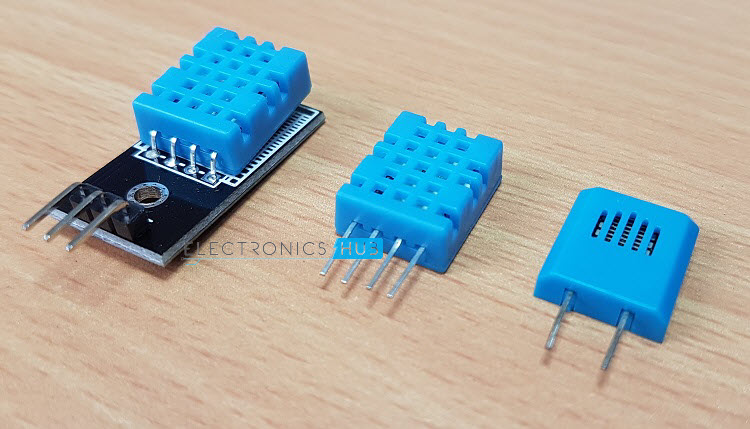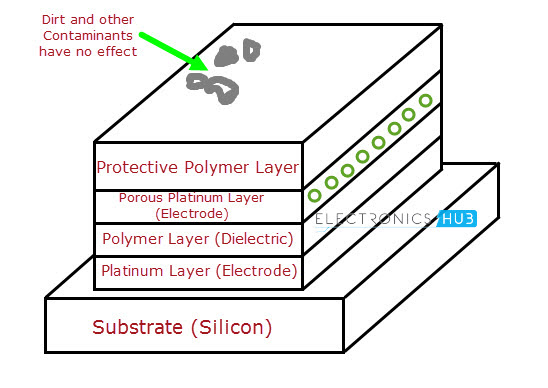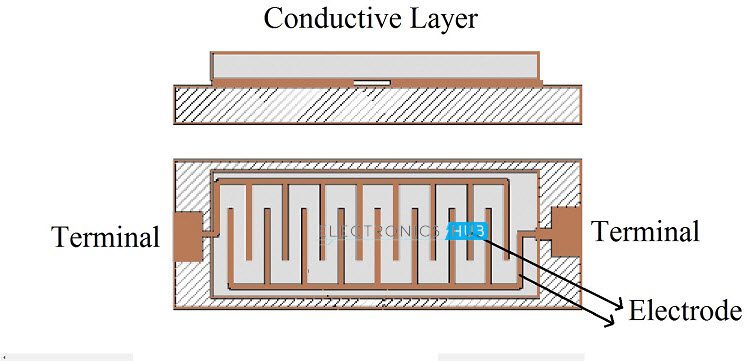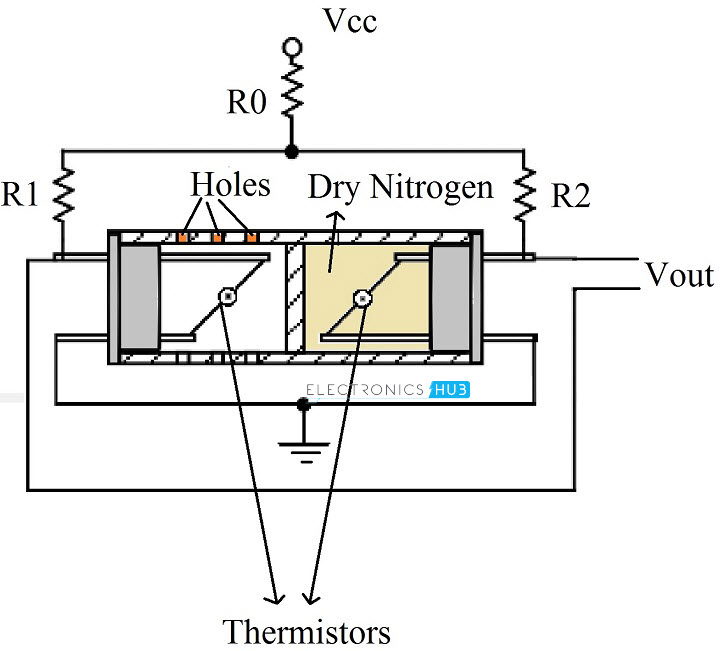Humidity is defined as the amount of water present in the surrounding air. This water content in the air is a key factor in the wellness of mankind. For example, we will feel comfortable even if the temperature is 00C with less humidity i.e. the air is dry. But if the temperature is 100C and the humidity is high i.e. the water content of air is high, then we will feel quite uncomfortable. Humidity is also a major factor for operating sensitive equipment like electronics, industrial equipment, electrostatic sensitive devices and high voltage devices etc. Such sensitive equipment must be operated in a humidity environment that is suitable for the device.
Hence, sensing, measuring, monitoring and controlling humidity is a very important task. Some of the important areas of application for sensing, measuring and controlling Humidity are mentioned below. Domestic: Sensing and controlling humidity in our homes and offices is important as higher humidity conditions will affect the blood flow. Other areas include cooking, indoor plantation etc. Industrial: In industries like refineries, chemical, metal, or other industries where furnaces are used, high humidity will reduce the amount of oxygen in the air and hence reduces the firing rate. Other industries like food processing, textile, paper etc. also need control of humidity.
Agriculture: Irrigation techniques like drip irrigation need accurate moisture content for plants. Also, the moisture in the soil plays an important role in the proper growth of the plant. Other areas where humidity control is required is indoor vegetation. Electronics and Semiconductor: Almost all electronic devices are rated with a range of humidity values in which they work as expected. Generally, this value will be something like 10% – 50% Humidity. Semiconductor Fabs (Fabrication Plants) should maintain very precise temperature and humidity values as even minute difference can show a huge impact in the production. Medical: Medical equipment like ventilators, incubators, sterilizers etc. need humidity control. It is also used in pharmaceutical plants and biological processes. All the above mentioned and many other applications need sensing of Humidity and is done using Humidity Sensors. Before discussing about Humidity Sensors, its types and working principle, we will first see some important terms and definitions related to Humidity.
Important Terms Related to Humidity
Moisture: Generally, the term Moisture means water content of any material or substance. But practically, the term Moisture refers to the water content in solids and liquids. The term Humidity refers to the water content in gases (air). Absolute Humidity: Absolute Humidity (AH) is the ratio of mass of the water vapour to the volume of the air. If m is the mass of the water vapour and V is the total volume i.e. volume of air and water vapour mixture, then Absolute Humidity AH is given by AH = m/V Absolute Humidity doesn’t take temperature in to account but it changes with temperature and pressure. Relative Humidity: Whenever we talk about measuring Humidity, it usually Relative Humidity that we are talking about (unless otherwise specified). Relative Humidity or RH is the ratio of the actual water vapour pressure present in the air at a temperature to the maximum water vapour pressure present in the air at the same temperature. In weather reports and forecasts, the probability of precipitation or dew or fog is indicated using Relative Humidity and hence, it is considered an important metric. Relative Humidity takes both temperature and pressure in to consideration. Hence, the Humidity Sensors which measure Relative Humidity, measure both the moisture content as well as the air temperature. NOTE: For temperatures above 1000C, measuring Relative Humidity (RH) is of no use as it would deliver misleading values. Specific Humidity: Specific Humidity (SH) is the ratio of mass of the water vapor to the total mass of the air. Mixing Ratio or Humidity Ratio: Mixing Ratio is the ratio of mass of the water vapor to mass of the dry air. Dew Point Temperature: Dew Point Temperature is the temperature at with the water vapor content is saturated in the air. At Dew Point temperature, the Relative Humidity RH is 100%. In other words, for the air to hold maximum amount of water vapor (or moisture), it has to reach Dew Point Temperature.
Humidity Sensors – Classification and Working Principles
Humidity Sensors are very important devices that help in measuring the environmental humidity. Technically, the device used to measure the humidity of the atmosphere is called Hygrometer. Humidity Sensors or Hygrometers can be classified based on the type of humidity it is used for measuring i.e. Absolute Humidity (AH) sensors or Relative Humidity (RH) sensors. Humidity Sensors can also be classified based on the parameter used for measuring Humidity i.e. Capacitive Humidity Sensors, Electrical Conductivity (or Resistive) Humidity Sensors and Thermal Conductivity Humidity Sensors. There are other types of Humidity Sensors or Hygrometers like Optical Hygrometer, Oscillating Hygrometer and Gravimetric Hygrometer. Let us see about different types of Humidity Sensors or Hygrometers along with their working principles.
Capacitive Humidity Sensors
Humidity Sensors based on capacitive effect or simply Capacitive Humidity Sensors are one of the basic types of Humidity Sensors available. They are often used in applications where factors like cost, rigidity and size are s of concern. In Capacitive Relative Humidity (RH) Sensors, the electrical permittivity of the dielectric material changes with change in humidity. A simple Capacitive RH Sensor can be made from an air filled capacitor as the moisture in the atmosphere changes its permittivity. But for practical applications, air as a dielectric is not feasible. Hence, the space between the capacitor plates is usually filled with an appropriate dielectric material (isolator), whose dielectric constant varies when it is subjected to change in humidity. The common method of constructing a capacitive RH sensor is to use a hygroscopic polymer film as dielectric and depositing two layers of electrodes on the either side. Another way to use the capacitive RH sensors is to observe the changes in the frequency of the oscillator constructed using a capacitor with RH sensitive test subject as dielectric. This setup is often employed in pharmaceutical products. The test samples like medical tablets are placed between two plates (which form the capacitor electrodes) to form a capacitor in the LC Oscillator circuit. The frequency of the oscillator changes with humidity surrounding the test sample.
Let us see the construction of a thin thermostat polymer film based capacitive RH Sensor. It is fabricated on a silicon substrate. On this substrate, two metal electrodes made of either aluminium, platinum or chromium are deposited. The shape of these electrodes is carved out such that, the electrodes form an interdigitized pattern. On top of this layer, a dielectric layer is deposited. The following image shows a top and cross section view of the capacitive humidity sensor. Note that two temperature sensitive resistors are deposited on the same substrate to provide temperature compensation.
The output voltage is near linear. They provide stable results over long usage. Can detect wide range of RH.
The distance from the sensor and signalling circuit is very limited.
Capacitive Humidity Sensors are used in a wide range of applications including but not limited to:
HVAC Systems Printers and Fax Machines Weather Stations Automobiles Food Processing Refrigerators, Ovens and Dryers
Resistive Humidity Sensors (Electrical Conductivity Sensors)
Resistive Humidity Sensors are another important type of Humidity Sensors that measure the resistance (impedance) or electrical conductivity. The principle behind resistive humidity sensors is the fact that the conductivity in non – metallic conductors is dependent on their water content. The Resistive Humidity Sensor is usually made up of materials with relatively low resistivity and this resistivity changes significantly with changes in humidity. The relationship between resistance and humidity is inverse exponential. The low resistivity material is deposited on top of two electrodes. The electrodes are placed in interdigitized pattern to increase the contact area. The resistivity between the electrodes changes when the top layer absorbs water and this change can be measured with the help of a simple electric circuit. Some of the commonly used materials are salt, specially treated substrates, solid polyelectrolytes and conductive polymers. Modern Resistive Humidity Sensors are coated with ceramic substance to provide extra protection. The electrodes in the sensor are usually made of noble metals like gold, silver or platinum.
Low cost Small Size The distance between the sensor and signal circuit can be large (suitable for remote operations). Highly interchangeable as there are no calibration standards.
Resistive Humidity Sensors are sensitive to chemical vapors and other contaminants The output readings may shift if used with water soluble products.
Resistive or Electrical Conductive Humidity sensors are low cost sensors with relatively small size. They are often used in several industrial, domestic or residential and commercial applications.
Thermal Conductivity Humidity Sensors
Thermal Conductivity Humidity Sensors are also known as Absolute Humidity (AH) Sensors as they measure the Absolute Humidity. Thermal Conductivity Humidity Sensors measure the thermal conductivity of both dry air as well as air with water vapor. The difference between the individual thermal conductivities can be related to absolute humidity. The best component to accomplish thermal conductivity based humidity sensor is thermistor. Hence, two tiny thermistors with negative temperature coefficient are used to for a bridge circuit. In that, one thermistor is hermetically sealed in a chamber filled with dry Nitrogen while the other is exposed to open environment through small venting holes. When the circuit is powered on, the resistance of the two thermistors are calculated and the difference between those two values is directly proportional to Absolute Humidity (AH).
Suitable for high temperature environments and high corrosive situations. Very durable Higher resolution compared to other types
Exposure to any gas with thermal properties different than Nitrogen might affect reading measurement.
Some of the common applications of Thermal Conductivity Humidity Sensors are:
Drying kilns Pharmaceutical plants Owens Clothes dryers and drying machines Food dehydration
Important Considerations when Selecting a Humidity Sensor
The following are some of the factor that must be taken into consideration when selecting a Humidity Sensor.
Accuracy of the sensor. Calibration – requirements and methods Size of the sensor Cost of the sensor and cost of replacement Output repeatability Circuit complexity Resistance to contamination Reliability of the sensor
Comment * Name * Email * Website
Δ











![]()